Home » Blog » Wine & Drink »
Dom Perignon 1996 – Those words alone should raise some brows amongst serious Champagne aficionados. In the wonderful world of Champagne, there is perhaps no wine more famous than the iconically shaped bottles of Dom Perignon – and, at the same time, perhaps none more controversial! Add to that the fate of the 1996 Champagne vintage – once unanimously hailed as the vintage of the century, now suddenly questioned by many experts – and this Champagne review should be an interesting read indeed.

The iconic Dom Perignon 1996 in all her glory!
Let it be known from the start, very few Champagne lovers deny that Dom Perignon is a superbly well-produced and iconic Champagne. As a matter of fact, many great wine reviewers hold older bottles of Dom Perignon in very high regard – and rightfully so. Dom Perignon, if kept and treated properly, will blossom beautifully with age.
However, Dom Perignon is also expensive, starting at well over $100 per standard bottle at release and escalating WELL into the thousands of dollars for older and/or larger bottles. As a result, Dom Perignon has earned a (somewhat justified) reputation of being a rich kid Champagne – opened in numbers at finer establishments around the world as a vulgar display of purchasing power – often in its very infancy without having had a chance to show its true potential.
Dom Perignon, you see, is usually released some eight years after harvest but takes considerably longer than that to truly shine. As a result, far too many bottles of Dom Perignon are opened far too early in their life for fairly obvious reasons: While some may have the setup and willpower needed to purchase a case at release and store for the ten, twenty or more years needed to release its true potential, most of us probably haven’t. And so we’re left with two choices, drink our Champagne young, or do what I did: put our trust and money in the hands of a wine merchant or brokers and the heavily fluctuating prices of a volatile wine market.
Which is not the most affordable option, might I add. At the time of this writing, a well-stored 21 year-old specimen from 1996 will set you back a good $400-500 – worth it? Let’s review it and find out! Then afterwards discuss how you best get your hands on an older bottle of vintage Champagne, should you desire to copy my move.
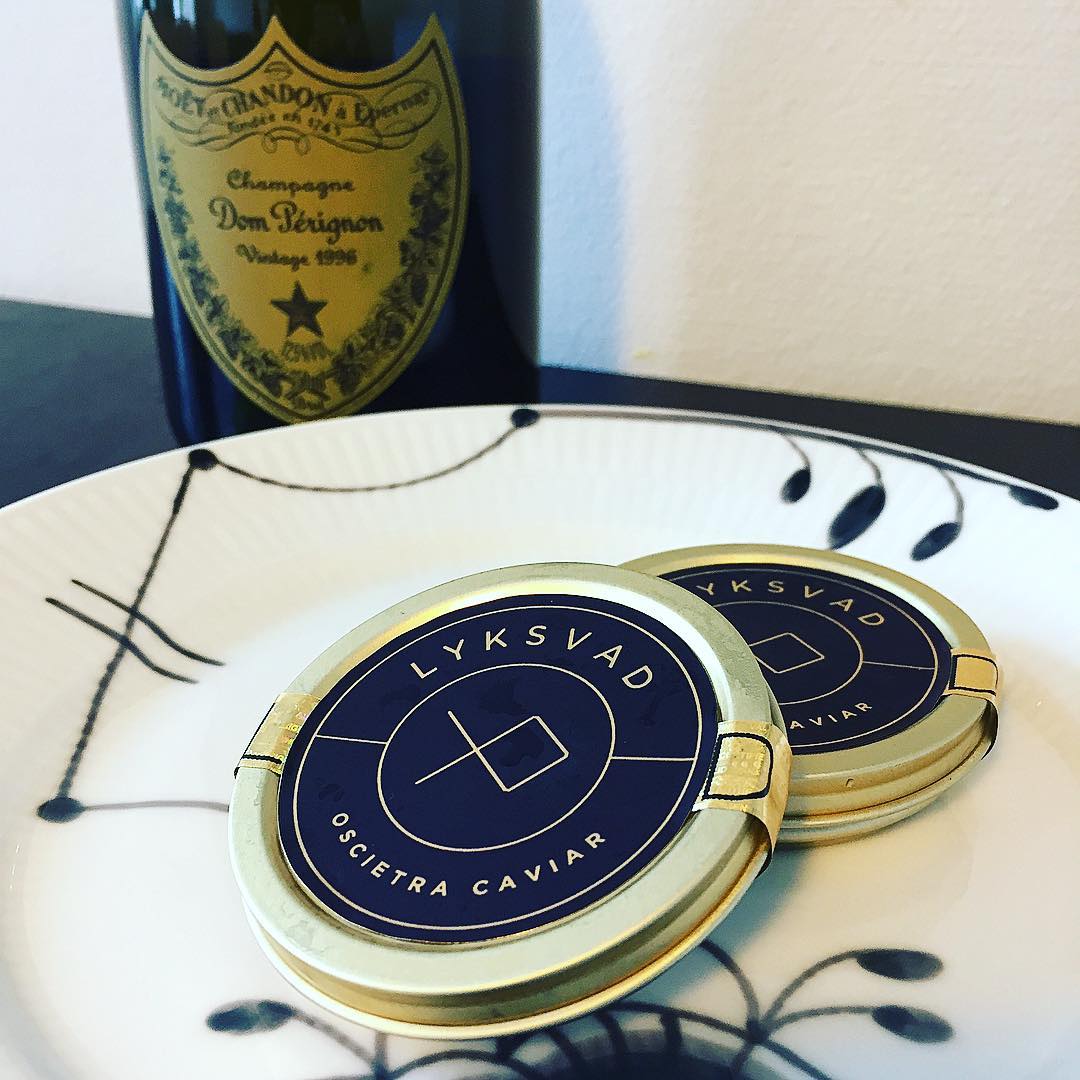
If you’re going to pay $450 for a bottle of Dom Perignon 1996, you may as well go all in and get a few tins of local Danish Caviar to go along!
1996: A Controversial Year for Champagne
The year 1996 has held a special meaning to Champagne geeks around the world and it may well be the most talked about and highly debated vintage of all time:
Not long after harvest, 1996 was quickly hailed by growers, producers and wine lovers alike as a force to be reckoned with. Many quickly ventured into labeling it with a number of superlatives: perhaps as good as the iconic 1928, perhaps the vintage of the century, possibly even the best vintage ever!
What made this iconic vintage so special, apparently, was a combination climate, atmospheric conditions and just plain coincidence:
A troubled flowering followed by seesaw summer weather with interchanging rain and sunny periods followed by downright heavy rains in September and a quick burst of heat just prior to picking somehow resulted in grapes that were full of flavor, sugars and acidity. These three things combined are essential to crafting long-lived quality vintage Champagnes and the very characteristics of the 1996 grape material showed, according to experts, promises of being the best vintage in recent history if not in our lifetime.
As is so often the case, rumor of great things to come spread like a wild-fire in the wine world and both prices and expectations soon sky-rocketed and kept doing so for years until not long ago when experts in droves started reversing their initial opinions, stating that the vintage may have mostly been carried forth on high hopes, clever marketing and hype.
In recent years, experts have very vocally revised their opinions on the iconic vintage. Decanter, for example, gave reasonably modest reviews for many top bottles from the 1996 vintage, including a 91 points rating for Dom Perignon. Not a bad score as such, but certainly not the score of the century either. Even more notably, highly regarded wine writer and early proponent of the 1996 vintage, Jancis Robertson, in an iconic piece titled 1996 Champagne – Still sparkling? argued that many 1996 bottles had lost their breath and that only true giants like Cristal, Krug and the recently disgorged and very expensive Dom Perignon 1996 Oenotheèue showed any real potential for the future.
The general consensus amongst experts now seems to be that while acidity remained high in many 1996 bottles, a shocking amount had started losing their fruit and character well before reaching perfect balance and drinkability. Not really the news you want to receive not long after investing a fair amount of money into the vintage.
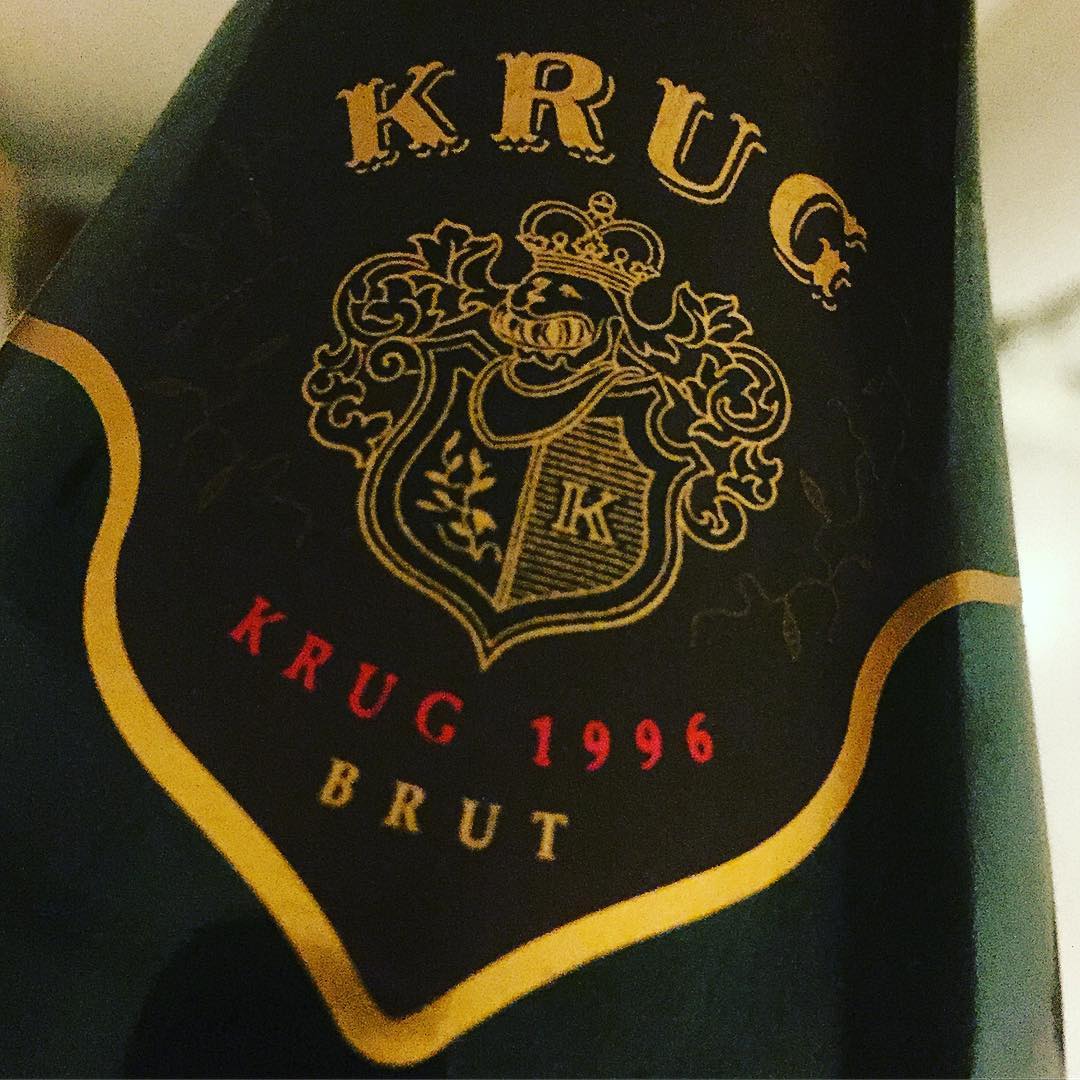
Apparently, Krug 1996 is where it’s at. Luckily, I also got a bottle of this particular Champagne while I was out spending money…
Had 1996 Champagne lost its fizz? Had purchasing and meticulously storing a bottle of Dom Perignon 1996 proved a silly mistake? There was but one way to find out. So on one not so average evening, during a Caviar tasting for a future blog post, Tina and I popped our most expensive and iconic bottle of Champagne to date.
Tasting Dom Perignon 1996
Quite surprisingly, the 1996 Dom Perignon opens with a surprising, refreshing pop and a mist of smoke, limestone and stone fruit which slowly rises from the neck of the bottle.
The first, gentle pour reveals a wine that shows no immediate signs of having spent the last two decades in a bottle: it pours a surprisingly light, barely golden, yellowish hue with an astonishing amount of perfect, little bubbles that rise vigorously from the bottom of the glass and break happily across the surface, showing no sign of fatigue after a lengthy imprisonment in the bottle.
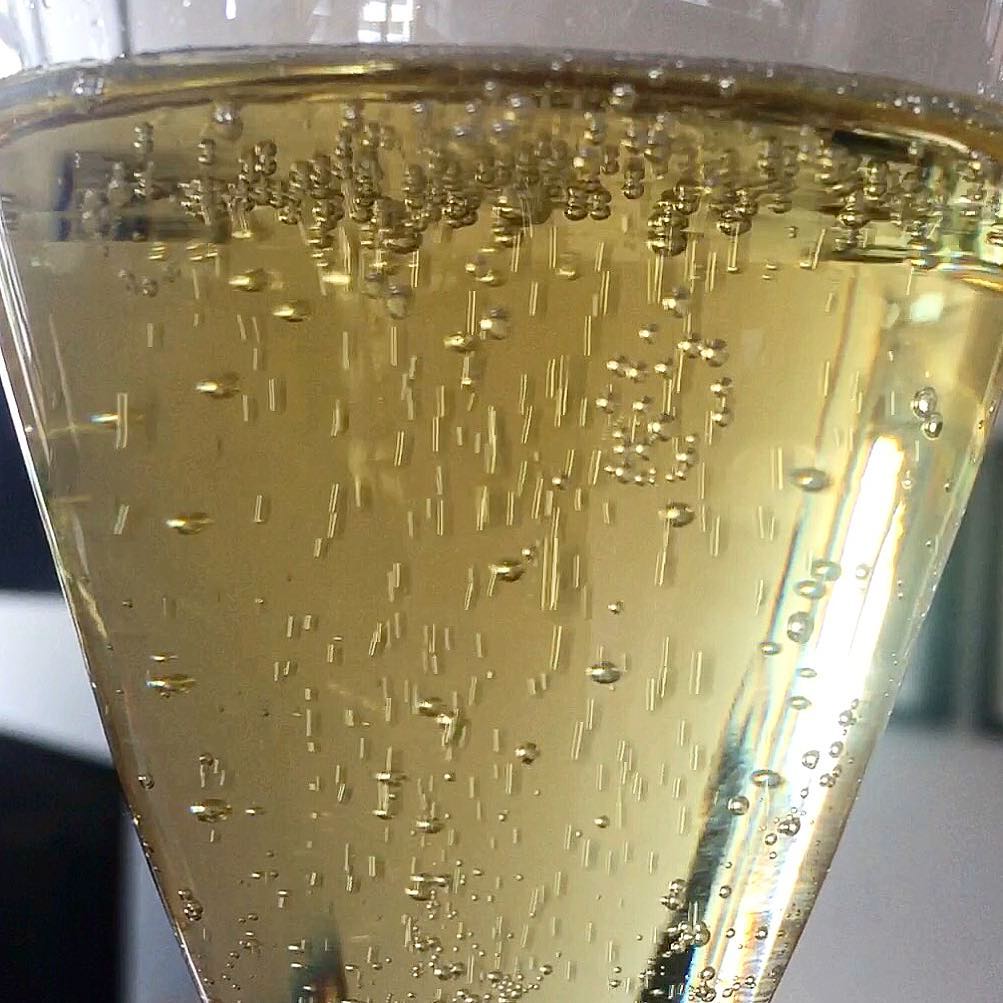
Vibrant, lively bubbles in a glass of Dom Perignon 1996. Had I not known, I would have never guessed this to be a 21 year old wine!
Upon first taste, it becomes shockingly clear that the 1996 Dom does not suffer the same faded fruit issue that some 1996 Champagnes are accused of. On the contrary, it seems almost entirely too young and not quite ready to act its age.
The initial taste has that wonderful signature young Dom Perignon touch: a flowery/fruity twist of fresh exotic fruits, pear and green apples blending with jasmine flowers on a mineral backdrop of limestone and chalk. Only in the aftertaste does it reveal its true age as a myriad of deeper, aged notes – toasted brioche, nuts, mushrooms and coffee – start fighting for attention against the immediate freshness.
As for the famed, raging acidity of the 1996 vintage, it’s very much still there and even after 21 years is still going strong. However, in the case of this Dom Perignon 1996, it has faded mercifully and now serves as an accent to the fruit rather than an over-powering, dominant force. It’s not yet perfectly integrated but it’s getting there and in doing so expresses hope for further development for this iconic wine.
But wait, it gets better. We shared the bottle over the evening and discovered that if left some time in the glass to aerate and grow, the 1996 Dom rewards the drinker with a multitude of expressions that range from at first young and vibrant to eventually rich, creamy and almost fully developed. With time in the glass, it opened up fully, rewarding us with a fruitiness that warped from fresh and vibrant into notes of baked apples and poached pears on a bed of secondary notes of baked sourdough, mushrooms, cream and toffee.
Is this slow development from young and fresh to aged and beautiful a sign of things to come? I shan’t say. At 21 years, Dom Perignon 1996 is the oldest bottle I’ve had to date but hopefully not my last mature Dom Perignon experience. Having made my way through the 2005 (review here), 2002 (review here) and 1996 vintages I can safely say that Dom Perignon despite its somewhat lacquered reputation is a force to be reckoned with. It starts its life vibrant, fresh, and underplayed, ages gracefully and slowly before finally starting to show its true form and potential as it travels past its teenage years. It took me three tries to finally understand that legend that is Dom Perignon, but by God I finally get it now.
Summing up Dom Perignon 1996: Thoughts and Score
Has 1996 Dom Perignon lost its fizz? If this bottle is anything to go by, then certainly not so. Rather, it’s showing signs of having a long and interesting life ahead of it. For now, it’s the perfect bridge between a young (in so far as 21 years old can be called young), vibrant Champagne and a beautifully aged, more voluminous masterpiece.
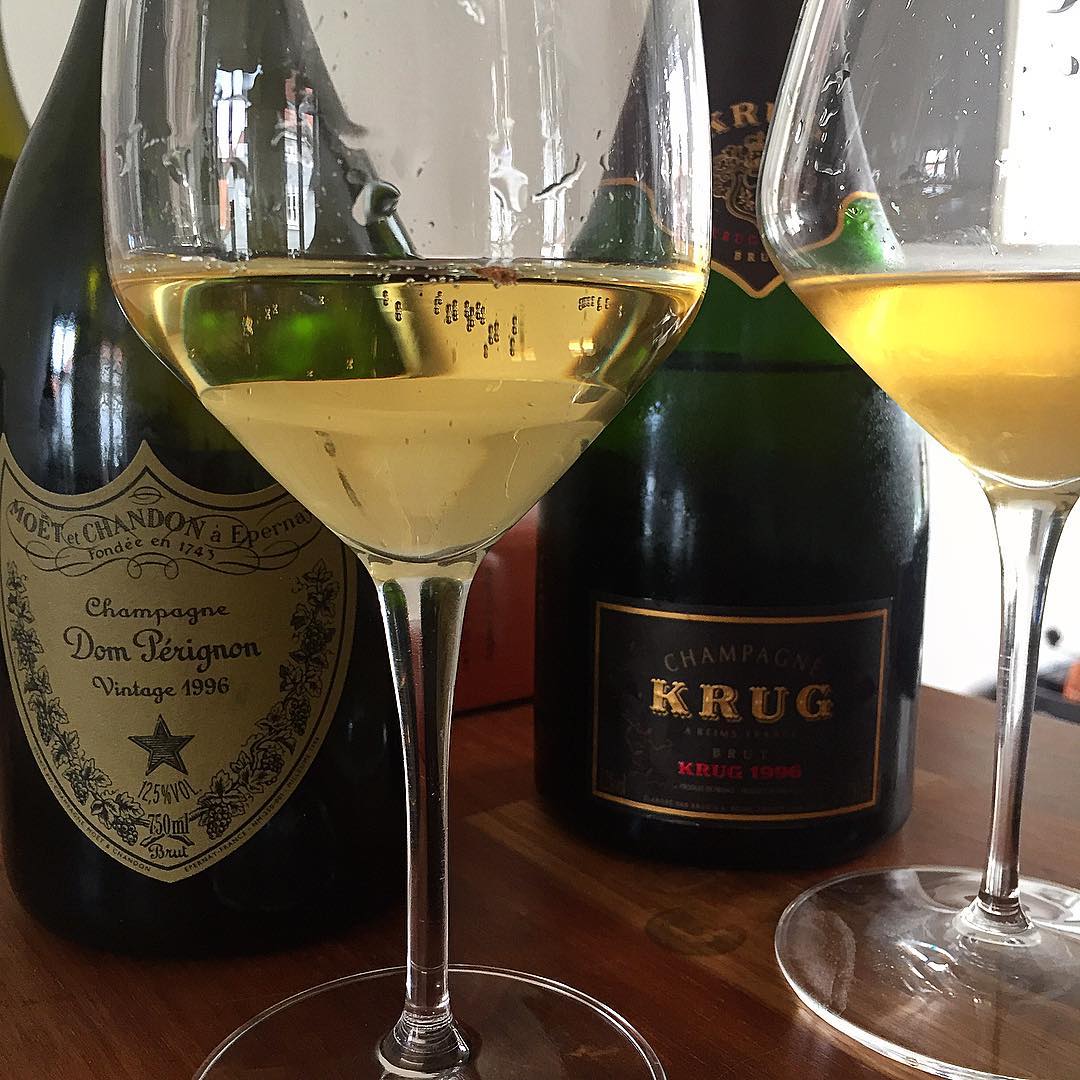
Two legends side by side: A glass of Dom Perignon 1996 alongside Krug 1996 – notice the considerably more golde, aged appearance of the Krug.
Now, as far as ratings go, the wine world stands divided. Respected wine magazine Decanter rated this a somewhat meager 91 points while Robert Parker’s Wine Advocate on the other hand nearly maxed out at 98(?) points. The truth, in the eyes of this reviewer with no personal bias to lean on, is somewhere between the two. I’ll, in fact, be controversial here and rate 1996 Dom Perignon exactly as highly as the (vastly different and more voluptuous) 1996 Krug I enjoyed beside it.
1996 Cuvée Dom Pérignon, Moët & Chandon, Épernay, France: 96 Points
Experiences like this clearly show that there are spectacular bottles of 1996 Champagne still out there, but finding them may take some persistence, investment and perhaps even luck. While the lesser 1996 Champagnes may be dying off, the giants of the vintage are still very much alive and are performing beautifully right now – if they have been treated well in the past 21 years of their lives, that is. Vintage Champagne probably more so than other wines is prone to bottle variation. Every single bottle of Champagne is essentially its own little microcosm of yeast, sugar and bubbles which have undergone secondary fermentation in the bottle and is often kept for a plethora of years. Under such circumstances, the exact content of the bottle certainly matters but as does storage and transportation conditions and external factors such as temperature, humidity and vibration.
So how do we make sure we procure a good bottle if we decide follow this review that we want to taste greatness? I’m glad you asked!
Buying vintage Champagne: A quick guide
First thing you will need to acknowledge and accept when sourcing vintage Champagne (and other great wines with age) is that there is always a certain risk that the project ends in disappointment or failure.
Most Cuvée Prestige Champagnes are built for the long haul and many age extraordinarily well. But even so, wine is a natural product and no matter the amount of technology, skill or thought involved in the production process, is still prone to variation, errors, faulty corks and damages caused by poor storage conditions.
Bottle variation, sadly, is a thing as are wine flaws and there is nothing we can do about it. We can however limit our chances of a bad experience by doing our research, making sure we get a bottle that has been treated well and taking the best possible care of it once it gets into our possession.
What this essentially means is that if you’re looking to buy an older bottle of wine for a special occasion, you’d do well to pick a seller you can trust and be ready to ask said seller a few questions. Don’t pick the first, best and cheapest bottle on Craigsbay or E-list or whatever those places are called. Pick a wine merchant or broker you trust to be reliable and then ask him about the history of the wine: how and when it came into his possession? From where? How it had been stored until it came into his possession and how it has been stored since? Questions of that nature.
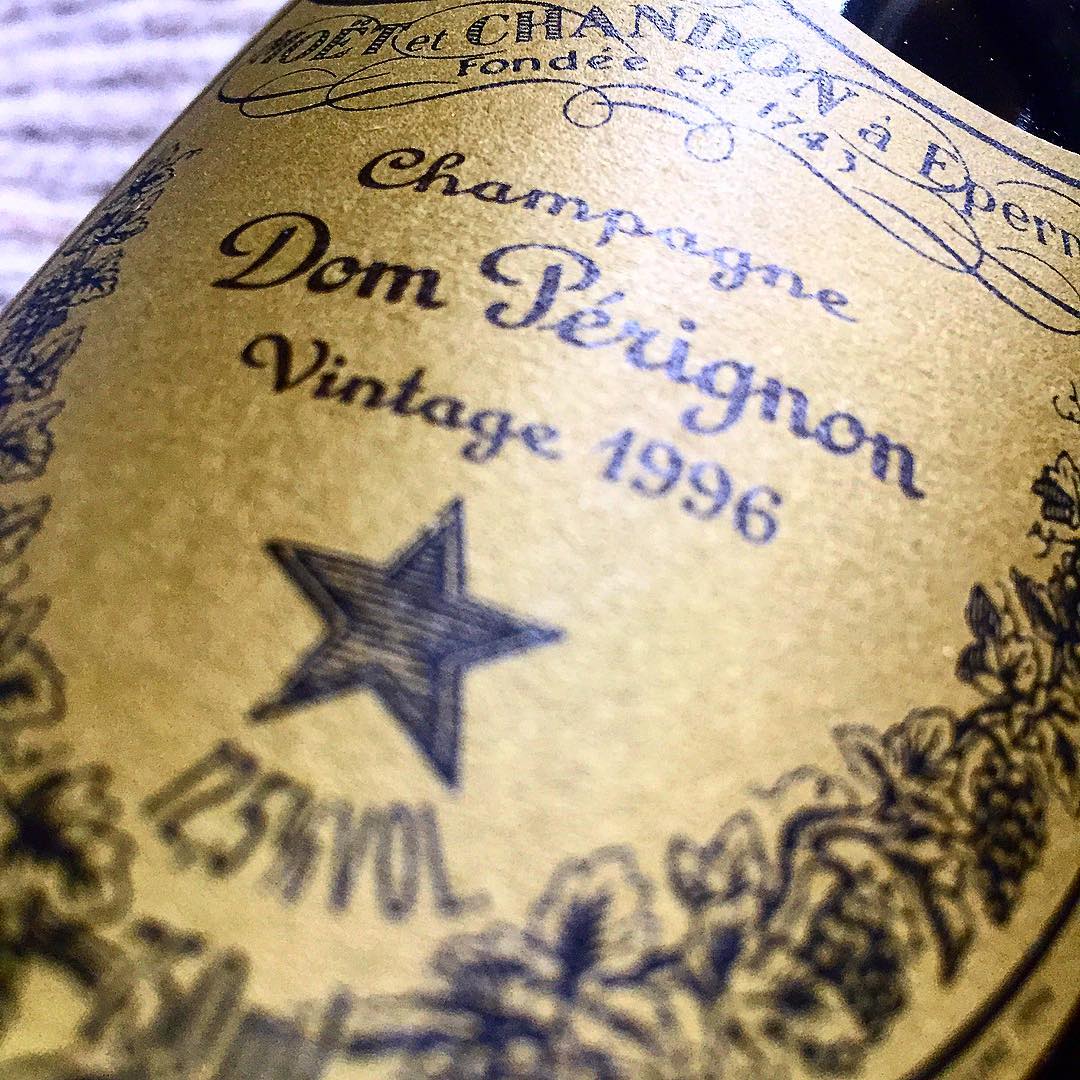
Close-up of a Dom Perignon 1996 label – this was one well-stored bottle of wine!
He’s probably not going to go into details about his sources and methods, but he should be able to paint a reasonably reassuring picture of what you can expect from his bottles. When I bought my bottle of Dom Perignon 1996 along with a Krug 1996, for example, the broker I dealt with informed me upon request that both bottles came from a reliable, private collector and had been stored in a wine fridge under perfect conditions. He also informed me of future bottles he had coming in at different price points and conditions, and took absolutely no notice or offence to the question. I was, after all, paying roughly $1000 for two bottles of wine and merely wanted a bit of reassurance! Professional sellers know and understand this so don’t be afraid to ask before spending your (presumably) hard-earned money. If you want to purchase good, old wine, it’s vital that it has been stored properly!
Size does matter: Serious about getting the best vintage Champagne experience? Having a lot of people over to help share the experience and bill? You might be interested to know that Champagne evolves considerably slower and better in larger bottles. A magnum usually tastes younger, brighter and fresher than a standard bottle from the same year, a double magnum even more so. Looking to share the joy? Then consider going big! The only problem? A magnum bottle is easily more than twice as expensive as a standard bottle – despite being only twice the size.
Oh and speaking of storage. If you’re planning to hang on to your precious Champagnes for any extended amount of time, like say more than a few months, you seriously need to contemplate long-term storage!
Storing vintage Champagne: a quick guide
The first and most important rule you will need to know about wine storage is to never store wine where most people do: the kitchen! The rapid fluctuation in temperature and humidity that takes place in such a space is a deathtrap to quality wine. And non-quality wine for that matter. For the very same reason, similar environments like boiler rooms or laundry rooms should be avoided as well.

Some bottles are meant for drinking, others are meant for storing. If you want to treat your Dom Perignon 1996 or other vintage Champagne with a little more respect than this idiot, then I’ve put together a little guide for you.
What you’ll want to do instead is lay your precious wines down in the darkest, coolest place you can find, preferably somewhere with a relatively high humidity. A cellar, quite obviously, works wonders here, but less will certainly do: an unheated storage space, a few unused shelves in an old cupboard, unused space under the stairs or an unheated outhouse with relatively stable temperatures year round are just a few ideas. What really matters more than anything is that you find a dark and relatively cool space with a constant temperature. More than anything, you see, wine dislikes light, extreme temperatures and rapid fluctuation in conditions:
Light, especially sunlight, is one factor that may seriously degrade or prematurely age wine. The colored bottles used for red wines and some white wines help reduce the impact of natural sunlight, but if you’re planning long time storage, it’s best to stash your precious wines somewhere dark and cool to play it safe.
Why cool, you may wonder? High temperatures, experts argue, may “cook” the wine, causing the fruit to fade and the wine’s flavors and aromas to turn flat. It’s a balance act here, though, as you won’t want things to get too cold either. While storing your wines in the fridge may seem like a good idea, the cold climate and resulting low humidity may cause shrinkage of the cork and oxidation of the wine. So what temperatures should you aim for? Experts argue that the ideal temperature for slow, controlled aging of wine fall within the area of 10 – 16C with a lot of people singling out 14C as the optimum. But while extreme cold and warmth should, obviously, be avoided at any cost, what is in fact more important than obtaining a “perfect” temperature is that you chose a specific temperature and stick with it over time.
Rapid temperature changes aside from running the risk of cooking the wine, may cause degradation of the cork, resulting in seepage or the dreaded phenomenon known as cork taint (or corked wine). Slow, gradual changes in temperature like a slow change caused by seasons shifting is not a problem but, daily fluctuations of several degrees, however, will quickly and severely shorten the life span of – and eventually damage – your precious wines.
And what of humidity? Humidity is a factor that many will tell you to worry about, but truth be told, humidity is probably the factor you’ll need to worry about the least. While true that low humidity will eventually dry out corks and may eventually cause oxidation or tainting of wines, such issues only occur after several years of poor storage. If you’re merely looking to store a wine for anywhere between a few months to a couple of years, I wouldn’t worry too much about humidity and simply lay the wine down on its side in a cool, dark spot.
The key takeaway here is to not panic! Unless you’re planning to store wine for a decade or more (at which point professional storage may be a thing to look into), you should think about your storage options, but not exactly overthink them either. Remember, wine is also supposed to be fun!
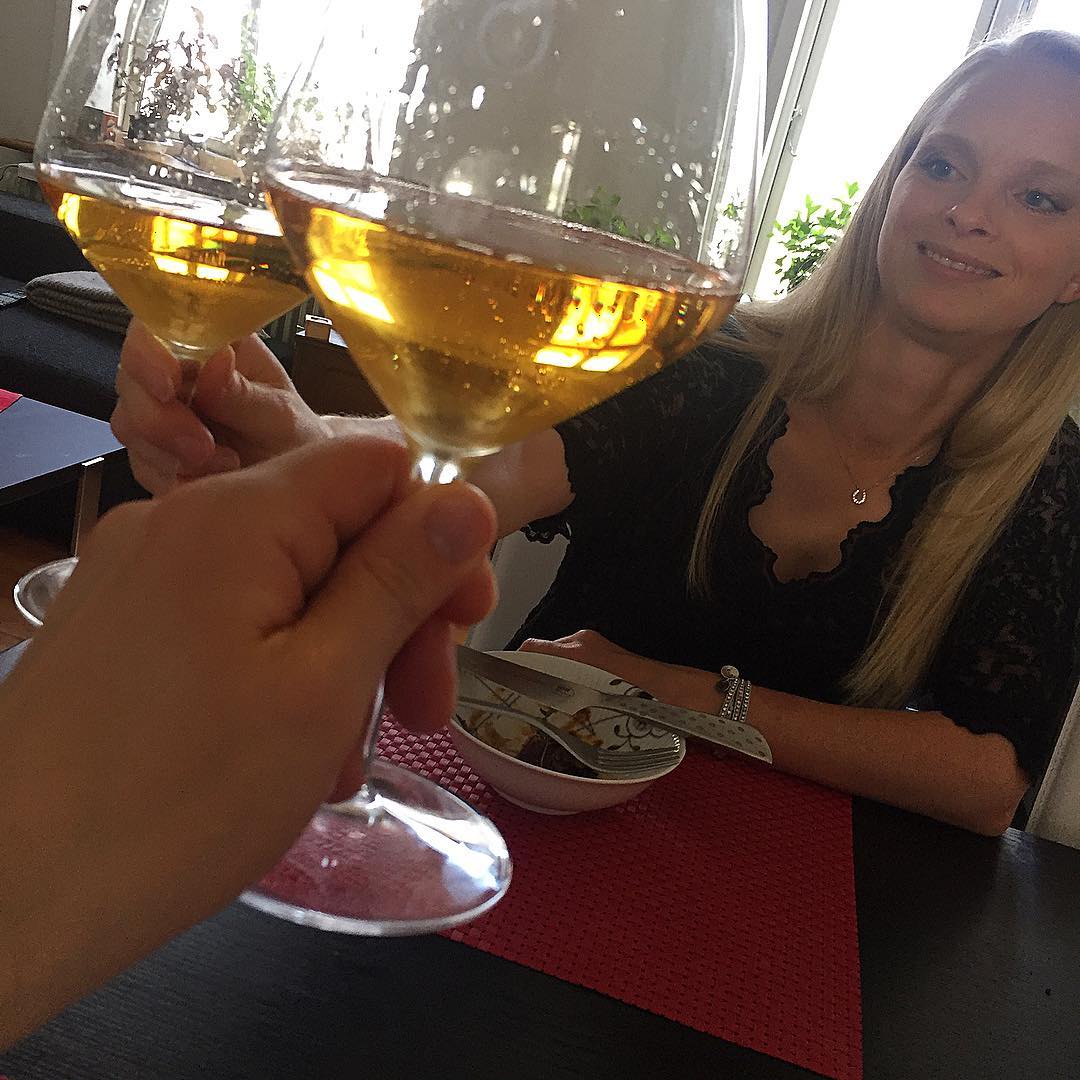
Procuring older vintages can be a hassle and an expensive venture. But sharing a perfectly aged Champagne in perfect company can be priceless!
Looking to buy a wine fridge? Read this first! If you really are dead serious about storing wines for several years or decades, you may already have started considering a dedicated, temperature controlled wine fridge. Before you do, though, ask yourself how serious you really are about collecting and read this guide about when (and when not) to look to a semi-professional storage solution.
Adhering to these simple rules, you should be able to purchase and even properly store a special occasion bottle of Champagne for at least a couple of years. Remember, though, that you are running a calculated risk by purchasing and storing a decade-old natural product.
Should you dare do it? The choice is yours, but if you do, I hope you’ll have the experience of a lifetime! And that you will let me know how it went, eh?
Hi I’m extremely happy with my purchase some years ago, I bought 3 bottles of 1996 and I never got round to enjoying them,, I never demeaned an occasion worth there while ,, but as I have three daughters I envisaged one bottle each on there wedding day,, or should I find a alternative and more appreciated home for these three bottles….?
Hi Jason! You should be, it’s an iconic wine. From what I hear, there are some variations on the bottles so depending on the age of your daughters, well… It may be more or less enjoyable. That being said, quality champagnes do last pretty much forever and they will certainly be drinkable if that’s even the point. The gesture, however, of having your father gift you one of the most iconic wines of the past decade on the day of your wedding… That really is something! 🙂
I have a bottle of this champagne that has been stored in a cabinet in my basement. Too bad I do not drink alcohol. Sounds like it would be amazing.
Hi, I’m searching for a 1996 Vintage Dom P for my husband’s 40th birthday. If this is what you have, would you be open to selling it?
With Regards,
Michelle B
Johan, what a lovely write-up! Thank you for that.
Received a bottle of 1996 Dom Pérignon vintage when our son was born January 2005. Wasn’t in the drinking mood, so I stored the champagne in the gift box on its side in the refrigerator, and there it sits. I am hoping to share it with him when he turns 21, along with my brother, who gifted it to us. That’s a bit down the road. In your opinion, will it be okay in another seven to eight years?
Trish, thanks for the kind words!
As for the drinkability? Ugh. Well, only one way to find out, I suppose. What I can tell you is that given the proper storage, it should be okay, even another 7-8 years down the line. I’ve never experienced myself with long-time refrigerator storage, so I can’t say myself if that’s a good way to store such bottles. I hear some so-called experts say that the low humidity of household refrigerators might dry out the cork, causing the wine to aerate and go bad. Whether or not this is the case, I can’t say, but I certainly don’t think the age would be a factor. Top Champagnes age extraordinarily well.
Hi there, I have been given a bottle of 1996 bottle of Dom Perignon Vintage in the box. The Box has been open and has been store in a cool dark place for the past years in my godmothers cellar of her home. Its been well taken care of. However I noticed the foil had a few minor scratches on it. Do you think this would effect it in any way? I currently keep it in the box in a nice cool, dry spot away from any light or heat. I quit drinking years ago and I would have loved to have tasted this beautiful bottle. Your revue of this Champagne sounds amazing.
Hiya! What a spectacular gift to be given! It’s hard not to get a tiny bit of wear and tear on a bottle over the course of so many years and no, I wouldn’t think that a few minor scratches would in any way affect the value and quality of the wine. The foil, after all, is largely cosmetic. I wouldn’t worry if I were you 🙂
What an extraordinary and complimentary review of this magnificent champage. It is always an elegant bottle but your photograph certainly does its beauty justice. I’ve never thought to age champagne so I will be on the lookout to find some decently priced vintage champagne to serve and revere. Thanks for your honest review.
Thank you so much for the kind words 🙂 Oh, I’d happily recommend shelving a vintage Champagne for a few years, it’s a very different experience, but quite a nice one at that!
Back in 2007 I received a Vintage 1996 Dom as a gift and have kept it in a cupboard all of these years. What are my chances it’s still good to drink or sell?
Dennis
Hi Dennis, I sent you an e-mail. Long story short: Provided that temperatures haven’t fluctuated too much, it should still be enjoyable. As for selling, I’m afraid most serious buyers would prefer if it had been kept in a designated wine fridge.
Hi Johan,
I have sealed and stored in box a 1990 vintage Cuvee Dom Perignon. Stored in a dark basement since I had my daughter in 1996. It was given to me as a gift. I never opened it. Wondering how much it might be worth. I live in NYC. Any ideas where I can find out. I have researched online and cannot find anything before 1996 thats not just an empty bottle for sale.
I appreciate any thoughts.
Thanks,
Sharon
Hi Sharon,
Thanks for popping by! Oh, geeze… Best I’ve been able to find myself was the following: https://www.quora.com/How-much-is-a-bottle-of-1990-Dom-Perignon-worth. I’m not familiar with the NYC wine market, but I suppose a local wine merchant specializing in rare/fine/older wines might be able to give you a clue or even make you an offer. Otherwise auction might be an idea. As a private individual looking to sell, I don’t think I’d expect more than the $3-400 range – tops.
Hi, my husband and I were given a bottle of 96 as a wedding gift in 2005, we were told we needed to be married more than a decade before opening. Now that we are approaching our 15th year we were thinking of opening it but not sure if we waited too long. Also, I was only 20 when I got married and hadn’t ever had champagne before, so it’s always been refrigerated, Hope I didn’t make a mistake by doing that. I love champagne now, but usually if I buy a bottle it doesn’t sit in the fridge for years on end. Looking forward to your professional opinion.
Hi Linda. Congratulations on your upcoming 15th wedding anniversary. I’m glad you’ve grown to love Champagne and that the giver of your wedding gift was wise with instructions. Unfortunately, I have little experience with wine adgign in home fridges. Some experts will claim that it’s a bad idea as low humidity may dry out the cork – but on the other hand, experience has taught me to not always listen to experts.
What I can tell you is that if the cork is indeed intact, and the bottle hasn’t been moved around much, you should have a very good experience on your hands that should be drinking better now for your 15th anniversary than it probably ever has and ever will. The best advice I can give is to give it a try and hope for the best. You’ll always have the bottle and the cork as a memory even if the wine has gone bad – and you’ll free some space in the fridge 🙂
I just discovered a bottle of 1996 Dom P (still in the sealed box)that was gifted to us when we were married in 2003….its been in my basement (we live in San Francisco so it stays fairly cool there)…we just did a remodel and I found it on a shelf next to a lovely bottle of cognac, also still in the box! From what I have read, it seems like the time is NOW to drink it…our 17 year wedding anniversary is coming up in Oct, I was thinking I will store it in my wine refrigerator (set at 55) until then…would that be advisable? Thank you!!!
Hi there! Happy upcoming 17th wedding anniversary. If the temperature is somewhat constant, it should still be good and tt certainly wouldn’t hurt to move it to more optimal storage conditions. Enjoy your once in a lifetime experience!
Hi Johan, I have two bottles of 1996 Dom P. They are in sealed unopened boxes and have been stored correctly. As we are unlikely to drink them I am considering selling them but don’t know how to go about it. Can you give me some guidance please ? Thanks.
Hey Graham, I’ve absolutely no idea, sorry. As I tend to drink mine 🙂 Maybe try a local wine merchant? Best of luck with the endeavor! 🙂
Hello, Johan. I really enjoyed your write up. My wife and I will be celebrating 25 years of marriage in February. She has always wanted to try Dom Perignon. As some quick math will tell you, we were actually married in 1996. I thought it would be nice to surprise her with a bottle of Dom Perignon from the year we were married. So, I started my research, discovered your blog and learned a lot about champagne. I had no idea that the 1996 vintage was held in such high regard. I am looking to purchase a bottle that I found thru what seems to be a reputable broker. I wanted to get your opinion about storage. I do not have a wine fridge, but I do have the perfect dark, cool place in my basement to store the bottle. I also wanted to ask your opinion about preparing the bottle for uncorking and drinking (i.e. put it on ice, in a normal fridge, etc.). I look forward to your guidance. Thanks
Hello, Derrick!
So happy you enjoyed the write up! And congratulations on nearing 25 years of marriage! A dark, cool place would be just perfect. Especially if we’re not talking longer than a month or so of storage. No worries there at all. As for preparation. I would simply put in the fridge the day before. I personally would not want it ice cold at serving as it masks some of the more subtle flavor nuances. I hope you have a most wonderful anniversary and some great bubbles to go along!
All the best,
Johan
In 1996 I bought 1996 bottle on Dom Perignon at the Canadian border, My family and I decided to open it last night to celebrate New Year 2022 I’am very seriously disappointed that it was spoiled. It was still in the original box, remove the wire, cork cover and the cork just pulled out without any effort, the bottle was half full; Wounder where the other half of the champaign went! How can I get my money back. Please advised. Thank you.
Hi Pitam,
Unfortunately I don’t see any way of getting your money back on a bottle that you have stored yourself for so many years. Now, if you had recently bought the bottle, most dealers would obviously refund it. I am sorry to hear about your experience. Sadly, in the world of wine, disappointing experiences do happen from time to time. Always a good idea to check back with the dealer to see if they have some sort of warranty or refunding policy.